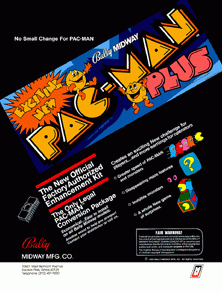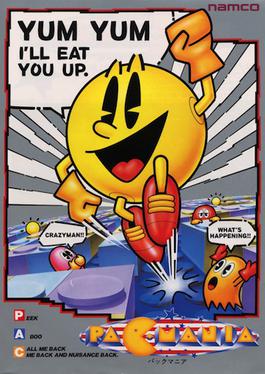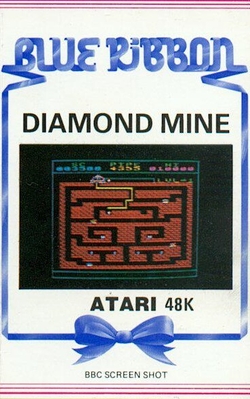Mini and mainframe clones

Pac-Man is a clone for the Xerox Alto, the first computer with a mouse-driven Graphical User Interface. The main character is controlled with a mouse.
PAC is a clone for the CDC 6000 series of mainframe computers.
In video gaming, Pac-Man clones are unauthorized versions of Namco's popular maze chase arcade video game Pac-Man or games that wholesale borrow the design of Pac-Man. The combined sales of counterfeit arcade machines sold nearly as many units as the original Pac-Man, which had sold more than 300,000 machines. [1]
Like the original game, Pac-Man clones typically have the goal of clearing a maze of dots while eluding deadly adversaries. When special dots are eaten, the protagonist can chase and consume the pursuers for a brief period. Clones may vary the audio/visual theme, use different maze layouts, slightly tweak features, or even invert elements such as filling the maze rather than emptying it, but they have the same general feel of Pac-Man.
The Giant List of Classic Game Programmers lists 57 Pac-Man clones released for various platforms. [2]
Lock 'n' Chase (1981) was developed and published by Data East in Japan and later in North America by Taito. Here, Pac-Man is replaced with a thief stealing coins from a bank vault. The ghosts are police, and the thief can temporarily block passages with doors. It was licensed to Mattel, which released Intellivision and Atari 2600 versions in 1982.
Mighty Mouth is a game by A-1 Machines that District Court Judge Warren Keith Urbom described as "for all practical purposes, identical to ...Pac-Man" [3] Among the similarities cited were the color and shape of the player character and ghosts, the maze configurations, the sound effects, the paths of the characters in the attract mode and the paths of the characters in both the attract mode and a game where the player does not move. [4] Midway, owners of the Pac-Man copyrights, were granted summary judgment for copyright and trademark infringement in 1983. [5]
Piranha (1981) was released by GL. The central character is a dot-chomping piranha, and squid creatures replace the ghost monsters.
The Hand (1981) was released by TIC. The central character is a dot-chomping hand, and the ghost monsters are replaced by hands representing Rock (a fist), Paper (splayed fingers), and Scissors (two fingers outstretched).
Thief (1981) was released by Pacific Novelty. The central character is the titular Thief in a getaway vehicle, while police officers in cars replace the ghost monsters. Thief uses scripted radio communications between the officers, played from a cassette tape inside the arcade cabinet.
Taxman (1981) for the Apple II was programmed by Brian Fitzgerald. [6] Atari sued Fitzgerald and he sold the port to Atari, which the company ended up selling as a licensed version of the game.
Ghost Hunter (1981) from Arcade Plus is a clone for the Atari 8-bit family that plays The Twilight Zone theme at the start of the game.
Jawbreaker (1981) for the Atari 8-bit family re-themed the gameplay, winning a best action game award in 1983.[ citation needed ] Atari threatened to sue the publishers, Sierra On-Line, but they released the game anyway. They won the ensuing lawsuit.
K.C. Munchkin! (1981) for the Magnavox Odyssey². In the 1982 case Atari, Inc. v. North American Philips Consumer Electronics Corp., an Appellate court found that Phillips had copied Pac-Man and made alterations that "only tend to emphasize the extent to which it deliberately copied the Plaintiff's work." The ruling was one of the first to establish how copyright law would apply to the look and feel of computer software.
Scarfman (1981) for the TRS-80
Gobble a Ghost (1982, CDS Micro Systems) for the ZX Spectrum
Hungry Horace (1982) for the ZX Spectrum
Munch Man (1982) is a clone from Texas Instruments for the TI-99/4A home computer. Instead of clearing a maze, the player fills it with "links" (in Munch Man parlance)—a change made by TI to avoid possible lawsuits.
Snack Attack (1982) is a clone for the Apple II written by Dan Illowsky and published by Datamost. [6] It became a top selling game for the Apple II. [7]
Snapper (1982). The initial release for the BBC Micro and Acorn Electron, [8] by Acornsoft, [9] [10] was so close to Pac-Man (including the design of the game's characters) that this version had to be withdrawn and re-released with the characters changed. [11] [12] The player's character became a round yellow face with very short legs wearing a green cowboy hat and the ghosts became skinny humanoid monsters.
CatChum (1981) was developed by Yahoo Software for Kaypro's luggable computers. It is a text-based game which uses dashes and various punctuation marks to construct a maze. The letter A serves as ghosts and the fruits are dollar signs. The main character is a letter C which alternates between upper and lower case, to simulate chomping.
3-Demon (1983) is a 3D vector-graphics Pac-Man clone developed by PC Research for MS-DOS. The game is placed in a 3D first-person perspective, with the ghosts being cyclopean demons.
Jelly Monsters (1981) for the VIC-20 is a port of Namco's Pac-Man by HAL Laboratory who had the home computer rights to Namco's games in Japan at the time. When the games were released in North America, the names were changed to avoid legal issues with Atari, Inc. who had the home computer rights in North America. Jelly Monsters for the VIC-20 was published by Commodore International. Atari ended up suing HAL and Commodore anyway and won the lawsuit, after which Atari pulled off HAL's VIC-20 port and released their own version.
Devil World (1984) for the Famicom was designed by Shigeru Miyamoto. [13]

Pac-Man is a clone for the Xerox Alto, the first computer with a mouse-driven Graphical User Interface. The main character is controlled with a mouse.
PAC is a clone for the CDC 6000 series of mainframe computers.

Pac-Man, originally called Puck Man in Japan, is a 1980 maze action video game developed and released by Namco for arcades. In North America, the game was released by Midway Manufacturing as part of its licensing agreement with Namco America. The player controls Pac-Man, who must eat all the dots inside an enclosed maze while avoiding four colored ghosts. Eating large flashing dots called "Power Pellets" causes the ghosts to temporarily turn blue, allowing Pac-Man to eat them for bonus points.

Ms. Pac-Man is a 1982 maze arcade video game developed by General Computer Corporation and published by Midway. It is the first sequel to Pac-Man (1980) and the first entry in the series to not be made by Namco. Controlling the title character, Pac-Man's wife, the player is tasked with eating all of the pellets in an enclosed maze while avoiding four colored ghosts. Eating the larger "power pellets" lets the player eat the ghosts, who turn blue and flee.
Acornsoft was the software arm of Acorn Computers, and a major publisher of software for the BBC Micro and Acorn Electron. As well as games, it also produced a large number of educational titles, extra computer languages and business and utility packages – these included word processor VIEW and the spreadsheet ViewSheet supplied on ROM and cartridge for the BBC Micro/Acorn Electron and included as standard in the BBC Master and Acorn Business Computer.

Dig Dug is a maze arcade video game developed by Namco in 1981 and released in 1982, distributed in North America by Atari, Inc. The player controls Dig Dug to defeat all enemies per stage, by either inflating them to bursting or crushing them underneath rocks.

Pac-Man Plus is an arcade game that was released by Bally Midway in 1983. It is part of the Pac-Man series of games.

K.C. Munchkin!, released in Europe as Munchkin, is a maze game for the Magnavox Odyssey 2. Its North American title is an inside reference to then president of Philips Consumer Electronics, Kenneth C. Menkin.

Super Pac-Man is a 1982 maze chase arcade game developed and published by Namco. It was distributed in North America by Midway, and is Namco's take on a sequel to the original Pac-Man; Midway had previously released Ms. Pac-Man, which Namco had little involvement with. Toru Iwatani returns as designer.
1982 was the peak year for the golden age of arcade video games as well as the second generation of video game consoles. Many games were released that would spawn franchises, or at least sequels, including Dig Dug, Pole Position, Mr. Do!, Zaxxon, Q*bert, Time Pilot and Pitfall! The year's highest-grossing video game was Namco's arcade game Pac-Man, for the third year in a row, while the year's best-selling home system was the Atari 2600. Additional video game consoles added to a crowded market, notably the ColecoVision and Atari 5200. Troubles at Atari late in the year triggered the video game crash of 1983.
Fueled by the previous year's release of the colorful and appealing Pac-Man, the audience for arcade video games in 1981 became much wider. Pac-Man influenced maze games began appearing in arcades and on home systems. Pac-Man was the highest grossing video game for the second year in a row. Nintendo's Donkey Kong defined the platform game genre, while Konami's Scramble established scrolling shooters. The lesser known Jump Bug combined the two concepts into both the first scrolling platform game and the first platform shooter. Other arcade hits released in 1981 include Defender, Frogger, and the Galaxian sequel Galaga.
1980 saw the release of a number of games with influential concepts, including Pac-Man, Battlezone, Crazy Climber, Mystery House, Missile Command, Phoenix, Rally-X, Space Panic, Stratovox, Zork, Adventure, and Olympic Decathlon. The year's highest-grossing video game was Namco's arcade game Pac-Man, while the best-selling home system was Nintendo's Game & Watch. The Atari VCS also grew in popularity with a port of Space Invaders and support from new third-party developer Activision.
Pac-Man is an American animated television series produced by Hanna-Barbera Productions and based on the Namco video game franchise of the same title. It premiered on ABC and ran for 44 episodes over two seasons from September 25, 1982, to November 5, 1983. It was the first cartoon based on a video game.

Pac & Pal is a 1983 maze chase arcade game developed and published by Namco. It is part of the company's Pac-Man series and the third to have been produced in-house. Players control Pac-Man as he must eat the items in an enclosed maze while avoiding four colored ghosts that pursue him. Pac-Man is assisted by a green-colored creature named Miru, the titular "Pal", who brings the items back to the center box. Pac-Man can also collect power-ups that allow him to briefly stun the ghosts.

Pac-Man is a 1982 maze video game developed and published by Atari, Inc. under official license by Namco, and an adaptation of the 1980 hit arcade game of the same name. The player controls the title character, who attempts to consume all of the wafers in a maze while avoiding four ghosts that pursue him. Eating flashing wafers at the corners of the screen causes the ghosts to temporarily turn blue and flee, allowing Pac-Man to eat them for bonus points. Once eaten, a ghost is reduced to a pair of eyes, which return to the center of the maze to be restored.

Snapper is a clone of the Namco arcade game Pac-Man programmed by Jonathan Griffiths for the BBC Micro and released as one of the launch titles for Acornsoft in 1982. It was also one of Acornsoft's launch titles for the Acorn Electron in 1983.

Pac-Mania is a cavalier perspective maze game that was developed and released by Namco for arcades in 1987. In the game, the player controls Pac-Man as he must eat all of the dots while avoiding the colored ghosts that chase him in the maze. Eating large flashing "Power Pellets" will allow Pac-Man to eat the ghosts for bonus points, which lasts for a short period of time. A new feature to this game allows Pac-Man to jump over the ghosts to evade capture. It is the ninth title in the Pac-Man video game series and was the last one developed for arcades up until the release of Pac-Man Arrangement in 1996. Development was directed by Pac-Man creator Toru Iwatani. It was licensed to Atari Games for release in North America.

Head On is an arcade video game developed by Sega/Gremlin and released by Sega in 1979. It's the first maze game where the goal is to run over dots. Designed by Lane Hauck at Sega/Gremlin in the United States, it was the fourth highest-grossing arcade game of 1979 in both Japan and the US.

Diamond Mine is a maze video game first published by MRM Software for the Acorn Electron and BBC Micro home computers in 1984. Diamond Mine was reissued by Blue Ribbon in 1985 and ported to other systems in 1985 and 1986. Blue Ribbon released a sequel, Diamond Mine II, at the same time. Both games are similar to the 1983 game Oil's Well, which itself is a re-themed version of the 1982 Anteater arcade game.

Taxman is a clone of Namco's Pac-Man written by Brian Fitzgerald for the Apple II and published by H.A.L. Labs, a firm he cofounded with Greg Autry, in 1981.

Atari, Inc. v. North American Philips Consumer Electronics Corp., 672 F.2d 607, is one of the first legal cases applying copyright law to video games, barring sales of the game K.C. Munchkin! for its similarities to Pac-Man. Atari had licensed the commercially successful arcade game Pac-Man from Namco and Midway, to produce a version for their Atari 2600 console. Around the same time, Philips created Munchkin as a similar maze-chase game, leading Atari to sue them for copyright infringement.
SNAPPER is an attractive and incredibly frustrating version of Pacman.
1983: SNAPPER, Acornsoft, £9.20 (Tape), £16.50 (ROM Cart)
SNAPPER, Acornsoft's implementation of the ever-popular Pac Man, was one of the first games ever released for the Electron.
Snapper was one of the first Video Arcade Conversions made for the BBC by AcornSoft.
This is one of the many quality arcade conversions that Acornsoft created for the BBC Micro, being a very faithful example of Pac Man.